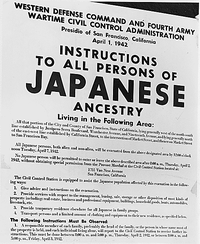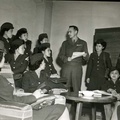* Speech presented by curator Eric Saul at the Japanese American National Museum on November 10, 2013 for the Go For Broke: Japanese American Soldiers Fighting on Two Fronts Member Preview Reception.
I think we all felt that we had an obligation to do the best we could and make a good record. So that when we came back we can come back with our heads high and say, ‘Look, we did as much as anybody else for this country and we proved our loyalty; and now we would like to take our place in the community just like anybody else and not as a segregated group of people.’ And I think it worked.
—Nisei soldier, Camp Shelby, Mississippi
Hawaii is our home; the United States our country… We know but one loyalty and that is to the Stars and Stripes.
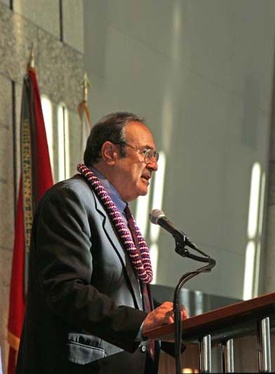
Eric Saul spoke at the special Member Preview for the opening of "Go For Broke" at the Japanese American National Museum on November 10, 2013 (Photo taken by Richard Murakami)
We are gathered here today to talk about a group of men. Men who fought for their country and for their community. They were fighting two wars: a war against prejudice and racism at home and a war to literally save the world from tyranny. It has now been more than 70 years since the first Nisei committed themselves to the fight for democracy.
Many of these Nisei have passed from this world and are no longer here with us to tell us their story. Some of you Nisei are in the audience today, and I will be addressing my remarks today to you.
You were among the 1,550 brave young men who, in the words of President Harry S. Truman, “fought not only the enemy, but fought prejudice, and won.”
Who were you? First of all, you were Americans. You happened to be of Japanese Ancestry. You were called Nisei. You were second generation, born in the United States. Most were born in the 1920s.
Where were you from? You were from Hawaii, Oahu, Maui, Kauai. You were also from California, Oregon, and Washington. You grew up in Honolulu, Los Angeles, Boyle Heights, the Paloma District, Fresno, Seattle, Portland, and in hundreds of small farming towns in the Western United States. You lived in the Little Tokyo and Nihonmachi of the big cities on the West Coast. In Hawaii, you grew up on plantations, where you toiled in the hot sun, helping to harvest and process the sugar cane.
You went to schools like McKinley, Garfield, and Roosevelt High School, named after the great presidents.
You were raised to be Americans. As American as apple pie and hot dogs. You studied the Constitution, the Bill of Rights, and American history. Every day, you pledged allegiance to the flag. You learned and were taught that you could aspire to anything that you dreamed. You were proud to call yourselves Americans. And you were proud to call yourselves Americans of Japanese Ancestry.
After school, you most often reluctantly attended Japanese language school. You resented having to sit in a classroom rather than playing baseball, football, or basketball.
But from your parents and these schools, you learned some special values. You learned of giri and on…having a sense of duty and a debt of gratitude. You learned gaman…quiet endurance. Gambaru…to persevere. You learned oyakoko…love of the family. You were taught kodomo no tame ni…the obligation for the family. You were taught enryo…humility. A sense of kansha…gratitude. Meiyo…honor. Hokori…to have pride. And haji…not to bring shame on the family.
They were values that even today we can aspire to.
As you grew up, you watched your parents slowly succeed in the small businesses, farms, fruit orchards, and nurseries. You saw your parents make a foothold in America. Your parents were Issei, who came to Hawaii and the mainland in the years before World War I.
As Nisei, you witnessed the relentless prejudice of racism that you and your parents had to endure. You were aware that you were different, and that it would be harder for you to succeed than for your neighbors of European ancestry.
As you Nisei entered your teen years, you were acutely aware of the laws that prevented your families from enjoying the full fruits of American democracy. You were aware that your parents could never become citizens. Couldn’t vote. Couldn’t own land. And couldn’t live where they wanted. You young Nisei were aware of the suspicion, the rumors, and the innuendoes made against you. It hurt you and made you feel unrightfully ashamed of your ancestry.
This prejudice and racism was, unfortunately, not unique in American history and culture. Other minorities had suffered the blows and indignities of xenophobia. Native Americans, African Americans, the Chinese, Italians, the Irish, Germans in World War II, and members of the Hispanic community, among others.
Despite the racism, your Nisei generation kept its head held high, with the pride of being an American of Japanese Ancestry.
In the early 1940s, you Nisei were coming of age, graduating high school and getting ready to go to college. At the moment when you should have looked forward to a bright and improved future, disaster struck.
The Japanese attack on Pearl Harbor was a brutal blow. You were soon reminded that your faces were not like other Americans—you had the face of the enemy and all that it represented.
Hundreds of you Nisei, from Hawaii and the mainland, raced to the recruiting offices. Your blood boiled with anger that the land of your parents would attack the United States. You knew that you could prove your loyalty by joining the fight.
But your country had unjustly lost faith in you. To your surprise and horror, you were told that your services were not wanted or needed. You were classified “4C”—enemy alien. When you heard “enemy alien,” you were discouraged, but you did not lose faith in a country that turned its back on you.
There were forces in the United States that would deal you and your families the cruelest blow ever. There was talk that you were disloyal, and that you even contributed to the Japanese attack on Pearl Harbor. You were accused of being spies and saboteurs, secretly waiting to spring up and attack your own country.
Soon, there were people calling for the removal and imprisonment of the Japanese community in Hawaii and on the mainland. Those groups included the growers’ associations in the Imperial Valley and the Central Valley in California. They were chambers of commerce, city and state governments. They were the Elks Club, the American Legion, Veterans of Foreign Wars, the Native Sons and Daughters of the Golden West, and many other organizations.
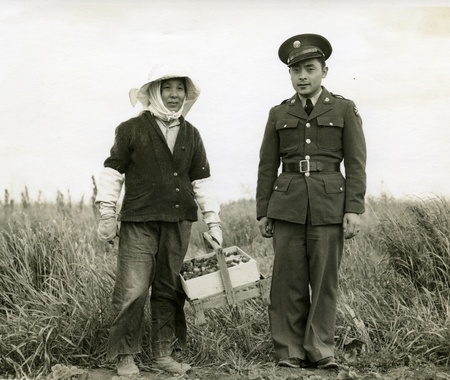
Young Nisei soldier who entered the Army before the war poses with his mother in their strawberry field in Northern California. This photograph was taken shortly before the soldier’s family was interned. This is a War Relocation Authority photograph. Image credit: National Archives
You had few friends and advocates, and even less political power. Who would stand up to these ever-louder cries of “The Japanese Must Go!”
These voices of intolerance and bigotry were heard in the halls of Congress. Who could have imagined that the entire Congressional delegation of the West Coast could have overwhelmingly demanded your imprisonment. Soon, the Army and even the President of the United States fell victim to the irrational and unjust cries for removal of Japanese Americans from the West Coast.
The worst fears of the Japanese American community were realized on February 19, 1942, when President Franklin D. Roosevelt signed Executive Order 9066. It was promulgated ostensibly to protect the West Coast under the false argument of “military necessity.” It didn’t specifically name Japanese Americans, but all those who wrote it, justified it, and implemented it knew it was targeted against Japanese Americans.
Soon, 110,000 Americans, many who had lived in the country for more than 60 years, were forcibly removed from their lands and businesses and homes. There were scarcely more than a few days to prepare. The economic loss was in the tens of millions of dollars. The loss to the Constitution and democracy was even greater. At a time when the laws protecting the rights of all citizens should have been the strongest, they buckled under the pressure of wartime hysteria, economic jealousy, greed, and expediency.
The wholesale removal of Americans from their property was a direct violation of every American tradition of law and justice.
The nation had turned its back on Japanese Americans. But Japanese Americans did not turn their back on their country.
Who would uphold the honor of the Japanese American community? Who would defend the principles of democracy and justice?
You, the young Nisei, many of you teenagers and in your early 20s.
It was you Nisei, yourselves, with your few friends in government and in the military, who petitioned for their right to serve in the Armed Forces. Many military officers felt that Japanese Americans could not be trusted bearing arms for the United States.
But cooler heads eventually prevailed and you Nisei were given the chance to defend democracy and fight the dual enemies of prejudice at home and the wartime enemies of democracy overseas. In 1942 through early 1943, after much soul searching, the Army lifted the ban and allowed the creation of first the 100th Infantry Battalion from Hawaii, and later the 442nd Regimental Combat Team.
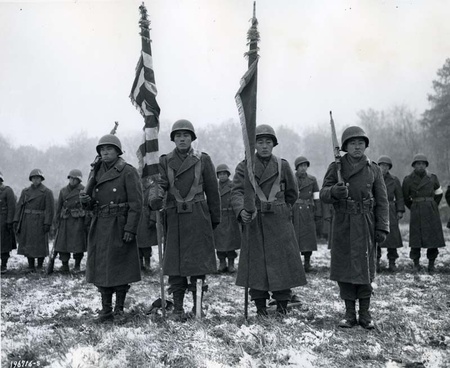
Photograph of the 442nd Regimental Combat Team color guard. This photograph was taken shortly after the rescue of the Lost Battalion. It was a ceremony to honor the 442nd RCT by the 36th Division commander, General Dahlquist. These soldiers were members of the Anti-Tank Company. The ceremony took place on November 11, 1944. Image credit: National Archives
* * * * *
Go For Broke: Japanese American Soldiers Fighting on Two Fronts
November 12, 2013 – March 2, 2014
Japanese American National Museum
Go For Broke: Japanese American Soldiers Fighting on Two Fronts chronicles the history of Japanese American Nisei soldiers from the 100th Infantry Battalion, 442nd Regimental Combat Team, and Military Intelligence Service who served during World War II to prove their loyalty to the nation that had disowned them.
© 2013 Eric Saul



